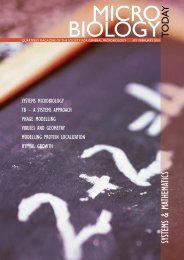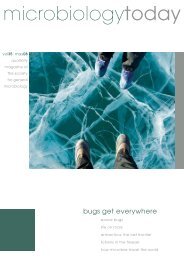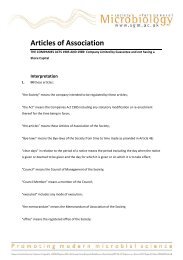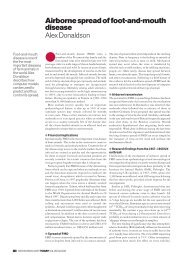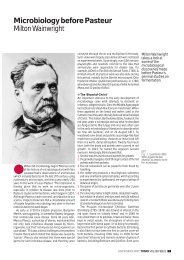Download - Society for General Microbiology
Download - Society for General Microbiology
Download - Society for General Microbiology
Create successful ePaper yourself
Turn your PDF publications into a flip-book with our unique Google optimized e-Paper software.
hotoffthepress<br />
Science writer Meriel Jones takes a look at<br />
some recent papers in SGM journals which<br />
highlight new and exciting developments in<br />
microbiological research.<br />
Getting into shape<br />
Pul, Ü., Lux, B., Wurm, R. & Wagner, R. (2008). Effect of<br />
upstream curvature and transcription factors H-NS and LRP<br />
on the efficiency of Escherichia coli rRNA promoters P1 and<br />
P2 – a phasing analysis. <strong>Microbiology</strong> 154, 2546–2558.<br />
The double helix structure of DNA is one of the great icons<br />
of the 20th century. However, DNA has additional structural<br />
features. As well as the exact sequence of the nucleotide<br />
bases, the shape of the DNA molecule is important. Each<br />
comparatively large DNA molecule folds to fit into the cell,<br />
but regions remain available <strong>for</strong> use at a moment’s notice,<br />
controlled by proteins and DNA structure. The DNA bases<br />
ahead of every gene are important <strong>for</strong> regulating when each is<br />
switched on or off by proteins binding at a region called the<br />
promoter. DNA curvature and regulatory proteins act together<br />
to regulate the efficiency with which genes are used, but many<br />
of the exact details are unknown.<br />
Researchers in Düsseldorf, Germany, have been studying how<br />
DNA and proteins interact at two promoters in Escherichia<br />
coli. The P1 and P2 promoters both regulate production of<br />
a structural RNA molecule required as part of the protein<br />
synthesis machinery. The DNA upstream of P1 is curved,<br />
while there is a complete lack of curvature upstream of P2. To<br />
test the relative importance of DNA structure and proteins, the<br />
researchers changed the DNA bases in the promoter region<br />
to vary the amount of curvature. Regardless of curvature, the<br />
gene could always be switched on, but the level of activity was<br />
highest when the inside of the curved section of DNA and the<br />
start of the gene were in the same plane.<br />
Proteins called transcription factors are normally involved<br />
in regulating gene activity through modulating interactions<br />
with the RNA synthesis system. The researchers went on<br />
to test the effect of three E. coli transcription factors called<br />
H-NS, LRP and FIS in conjunction with the curved DNA<br />
molecules. FIS activates P1 promoters while LRP and H-NS<br />
inhibit transcription from them. The subtle effects seen with<br />
the differently curved molecules differed between P1 and P2,<br />
indicating that these two promoters are regulated differently,<br />
with P1 being more strongly inhibited.<br />
From these results it is evident that the combined effects of<br />
DNA curvature and several transcription factors cause the<br />
different levels of activity of each gene, but much more work<br />
is needed be<strong>for</strong>e accurate predictions can be made <strong>for</strong> every<br />
gene.<br />
Bugs and colon cancer<br />
Allen, T.D., Moore, D.R., Wang, X., Casu, V., May, R.,<br />
Lerner, M.R., Houchen, C., Brackett, D.J. & Huycke, M.M.<br />
(2008). Dichotomous metabolism in Enterococcus faecalis<br />
induced by haematin starvation modulates colonic gene<br />
expression. J Med Microbiol 57, 1193–1204.<br />
The colon is home to around 10 11 bacteria per gram of<br />
contents. For many years, scientists have argued about<br />
whether the presence of this vast microbial horde is always in<br />
the best interests of its human host. Specifically, the idea that<br />
some bacteria are involved in sporadic colorectal cancer has<br />
been around, but unproven, <strong>for</strong> decades. The major difficulties<br />
with making any progress are that most of the microbes have<br />
not been identified and the interaction between bacteria and<br />
the surface of the colon has many unknown features.<br />
To make progress, scientists in Oklahoma, USA, have<br />
concentrated on bacteria that are known to damage DNA since<br />
this could start the genetic changes required <strong>for</strong> cancer. The<br />
damage is caused by highly reactive <strong>for</strong>ms of oxygen known as<br />
superoxide, hydroxyl radicals and hydrogen peroxide which<br />
diffuse from some bacteria when they are stressed and into the<br />
surrounding animal or human tissues.<br />
Novel bone disease mycobacterium<br />
Bang, D., Herlin, T., Stegger, M., Andersen, A.B., Torkko, P.,<br />
Tortoli, E. & Thomsen, V.O. (2008). Mycobacterium arosiense<br />
sp. nov., a slowly growing, scotochromogenic species causing<br />
osteomyelitis in an immunocompromised child. Int J Syst<br />
Evol Microbiol 58, 2398–2402.<br />
The most well known Mycobacterium species is M. tuberculosis,<br />
infections of which can result in the disease tuberculosis.<br />
Closely related species that cause different, rarer diseases can<br />
now be distinguished using molecular genetic and chemical<br />
analyses. Several have been identified as the cause of infections<br />
in children’s bones, although most of these infections have<br />
<strong>for</strong>tunately not been severe. However, treatments with<br />
antibiotics to kill the bacteria are quite prolonged and the<br />
disease can recur. One recent serious infection in a 7-yearold<br />
girl, who had inherited a problem with her immune<br />
system, was caused by what turned out to be a novel species<br />
of bacteria. She responded well to therapy with a mixture of<br />
antibiotics <strong>for</strong> over a year, with no signs of recurrence of the<br />
infection after a further 18 months. However, she probably<br />
remains at life-long risk from non-tuberculous mycobacteria.<br />
Staff working at the International Reference Laboratory of<br />
Mycobacteriology and National Center <strong>for</strong> Antimicrobials and<br />
Infection Control at Copenhagen in Denmark, along with<br />
colleagues at other laboratories in Denmark, Finland and Italy,<br />
studied the bacteria in detail because their features did not<br />
correspond exactly to any known species. The yellow-coloured<br />
bacterial cells grew slowly and looked like typical clinically<br />
significant mycobacteria under the microscope. However,<br />
The authors have been experimenting with Enterococcus<br />
faecalis, a minor inhabitant of the colon but one that can<br />
cause DNA damage and promote chromosomal instability by<br />
releasing reactive oxygen species. They wanted to know how<br />
the colon responded to this threat. They have discovered that,<br />
although the colon tissue looks perfectly normal under the<br />
microscope, the activity of several genes altered rapidly once<br />
the bacteria released oxidizing chemicals. Looking in more<br />
detail, the researchers proved that E. faecalis could activate the<br />
NF-κB signalling pathway in white blood cells – this signal<br />
can promote tumours.<br />
After checking 5,000 genes, the researchers identified 42 that<br />
increased or decreased in expression. Several were involved<br />
in the immune response, while 9 were implicated in stress<br />
responses and a further 10 in control of whether the cell<br />
should divide or die. Looking into the roles of these genes in<br />
more detail brought out the message that E. faecalis affects a<br />
single response network that contains NF-κB signalling and<br />
several genes that have been implicated in cancer biology.<br />
The argument about the role of bacteria in colon cancer has<br />
thus moved <strong>for</strong>ward with implication of specific mechanisms<br />
through which E. faecalis can increase the susceptibility of<br />
colon cells to DNA damage.<br />
more detailed tests that recorded the sequence of several<br />
genes from the bacteria showed some differences from all<br />
known species. In addition, some results from growth on<br />
various laboratory media and an analysis of the fatty and<br />
mycolic acids from the cells matched with several different<br />
species.<br />
Putting all the in<strong>for</strong>mation together, the researchers have<br />
convincing evidence <strong>for</strong> a new species that is closely related to<br />
M. intracellulare, but very clearly different from it. They have<br />
named it M. arosiense after the Latin name of Aarhus, the city<br />
in Denmark where it was first identified.<br />
m Coloured scanning electron micrograph of a T-cell (orange) infected<br />
with HIV viruses (blue). Eye of Science / Science Photo Library<br />
HIV by numbers<br />
Hogue, I.B., Bajaria, S.H., Fallert, B.A., Qin, S., Reinhart, T.A.<br />
& Kirscher, D.E. (2008). The dual role of dendritic cells in the<br />
immune response to human immunodeficiency virus type 1<br />
infection. J Gen Virol 89, 2228–2239.<br />
Trying to understand exactly why HIV-1 invariably causes<br />
a lethal infection has highlighted our lack of understanding<br />
of many of the complex interactions in the human immune<br />
system. Cells have dual roles, as targets <strong>for</strong> disruption by<br />
HIV-1 and as essential components in an immune response to<br />
counter the infection. Hogue et al. have tried a new approach<br />
to this problem by creating a mathematical model to describe<br />
how HIV-1 and cells interact in a human lymph node.<br />
In the decades since HIV-1 was identified, much data have<br />
been recorded on how the numbers of viral particles and<br />
different types of human cells change throughout an infection.<br />
Myeloid dendritic cells (DCs) in the lymph nodes activate<br />
T-cells to defend against HIV-1. One type of T-cell, CD8+,<br />
has the main protective role against HIV-1 infections through<br />
killing infected cells and releasing antiviral factors. Another<br />
T-cell type, CD4+, is also important in the body’s defences,<br />
but is attacked by the virus. DCs can thus promote immunity<br />
as a link between the virus and T-cell defences, but are also<br />
used by HIV-1 to boost infection. It is difficult to study DCs<br />
directly because they reside within lymph nodes which cannot<br />
be examined easily. The advantage of a mathematical model<br />
in this situation is that it may predict factors that govern the<br />
infection and which are easier to test experimentally.<br />
In the first few weeks of infection there is usually a large<br />
amount of virus in the body and substantial immune system<br />
activity. This stabilizes into a long-term chronic infection<br />
that can last years, characterized by much lower numbers of<br />
virus particles. Eventually, <strong>for</strong> unknown reasons, this stable<br />
state breaks down, CD4+ cell counts decrease, the levels of<br />
virus increase, and the patient experiences the debilitating<br />
symptoms of AIDS. All the mechanisms proposed <strong>for</strong> this<br />
change imply that DCs are of key importance, but <strong>for</strong> several<br />
different reasons.<br />
The equations were designed using in<strong>for</strong>mation from human<br />
patients and similar immunodeficiency viral infections<br />
in primates. The idea was to have terms <strong>for</strong> documented<br />
significant interactions between HIV-1, DCs, CD4+ and CD8+,<br />
concentrating on DCs. The model was good at simulating<br />
the numbers of each type of cell in a healthy human lymph<br />
node, and in showing how HIV-1 infection results in T-cell<br />
depletion. Using mathematical methods <strong>for</strong> uncertainty and<br />
sensitivity analysis allowed the testing of different hypotheses<br />
about the roles of DCs. The way that DCs simultaneously<br />
infect and alert CD4+ cells seemed to be crucial in establishing<br />
infection. Later on, failure of proper DC function has a greater<br />
effect on pathogenesis of the disease than the loss of CD4+.<br />
One practical outcome of this modelling is to suggest that<br />
treatments that improve DC functions could be valuable in<br />
improving the outcome of HIV-1 infections.<br />
212 microbiology today nov 08<br />
microbiology today nov 08 213



